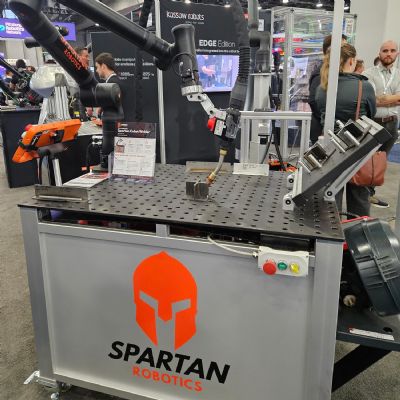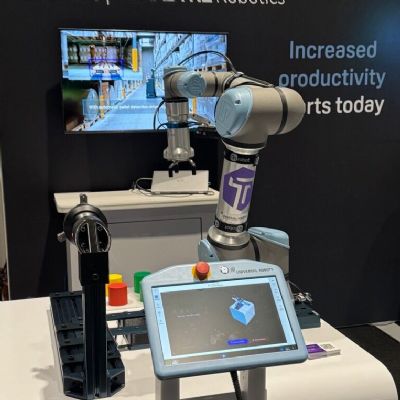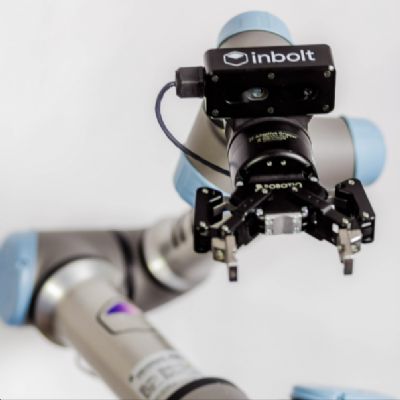“Where you might think to avoid automating low-margin tasks,” Losey says, “we see that companies choosing to automate these tasks free their human labor to perform more value-added work. This strategy balances out their overall human-capital costs.”
“Before investing in new projects and deciding on the accompanying skilled-labor requirements, manufacturers should establish clear goals when developing new automation projects,” adds Steve Barsanti, Rapid Robotics’ vice president of customer operations. “Are you trying to automate a specific task because it’s a challenge for you, or is the goal to offset the labor burden because you can’t find people? If it’s the latter, then work at defining the right tasks to automate. As Kim says, it’s often a good idea to automate the easier manual tasks and free labor to handle the more difficult tasks on the plant floor.”
Robot Manufacturers Obliged to Help Educate the Workforce
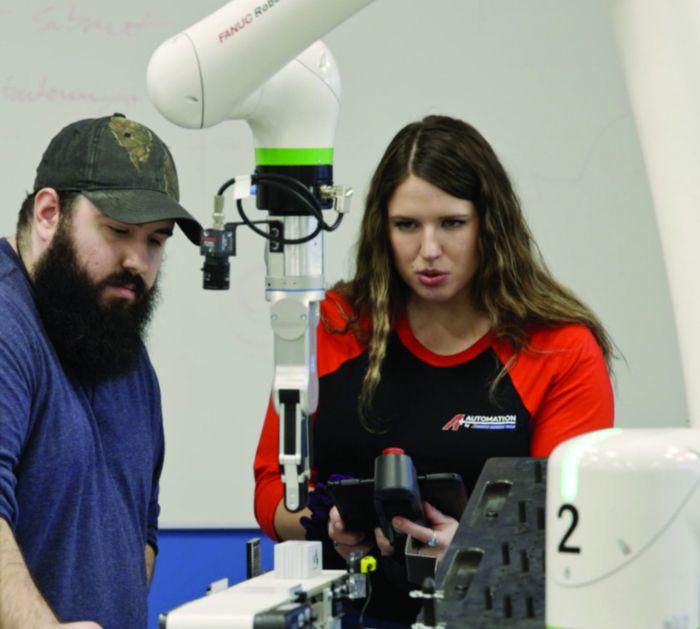 Robot vendors such as Yaskawa Motoman and Fanuc, faced with knowing that their customers struggle to hire and retain trained robot operators, programmers and maintenance technicians, continue to develop new tools to overcome workforce-related challenges. Explains Fanuc’s Paul Aiello: Robot vendors such as Yaskawa Motoman and Fanuc, faced with knowing that their customers struggle to hire and retain trained robot operators, programmers and maintenance technicians, continue to develop new tools to overcome workforce-related challenges. Explains Fanuc’s Paul Aiello:
“The industry needs more predictive analytics to compensate for a lack of dedicated equipment-maintenance techs. To support our customers faced with maintenance-related challenges, we’ve developed a software platform called Zero Downtime (ZDT)—a collection of analytics to help users verify the health of every connected robot on the shop floor. ZDT analyzes robot data and populates a dashboard for the operators, maintenance people and plant managers so that they can optimize their overall maintenance costs and task scheduling. These types of digital tools will help a metal former direct its maintenance resources in a timely and efficient manner.” Yaskawa Motoman’s Clint Chapman points to similar initiatives, starting with its dedicated website. The website houses maintenance videos, he explains, instructing on how to take apart and reassemble all of a robot’s motors and drives, wiring harness, etc., going back several generations of its robots. “We’ve also developed a new virtual classroom called MotoSim Touch that metal formers can use to simulate a robotic cell. Operating on our MotoSim offline robot-programming and simulation-software platform, students can create robotic applications including programming, modeling and diagnostics in a simulation environment—no robot needed—and toggle between a virtual or a hardware pendant. “Schools can use this technology,” Chapman adds, “to mitigate risk during training, and it provides a low-cost way to gauge interest that potential students in their specific community might have in robotic education, before investing in full-fledged program.” |
Once robotic-automation projects have been thoughtfully and carefully defined and specified, and the equipment and required labor needs identified, metal formers should prepare to invest in workforce development, and budget for the higher skilled labor required to operate, program and maintain the robots. In the last 10 to 15 yr., robot-specific training programs have sprung up all over the country, many supported in various ways by the robot manufacturers themselves. We spoke with a couple to learn how they’re supporting their customers by working to develop the required workforce of the future.Clint Chapman, senior manager, strategic partner relations for education and workforce development at Yaskawa Motoman, says: “In the last 5 yr., we’ve had numerous customers come to us wanting to dip their toes into automation, yet completely unsure of where to start. ‘Margins have been shrinking,’ we hear, ‘so how can we drive costs down?’”
Explaining further, “robotic automation is a good answer,” Chapman continues, “but the process is based on the ability to try, which is where the RaaS model does the industry a great service. That model has brought new customers to robot companies and expanded the bandwidth of manufacturers who can apply automation, with minimal investment and minimal human support. The result: RaaS companies take some of the staffing burden away from robot users, while making companies nimbler. A metal former can lease a robot or cobot when it needs one for specific projects, and send it back when the projects end.”
Most recently, Rapid Robotics announced a new integration with Yaskawa Motoman, to bring industrial capabilities to Rapid Robotics’ turnkey solution dubbed Rapid Machine Operator (RMO)—basically, a preprogrammed ready-to-hire robot or cobot ready to go to work on day one.
“We now are integrated with the entire Yaskawa robotics portfolio,” Rapid Robotics’ Barsanti explains, “and can deliver more speed, higher payload and increased performance to a greater number of North American manufacturers with a more diverse range of needs.”
Process Experts Make Good Robot Operators
As companies look to supplement their skilled workforce with robots and identify the human skills they’ll need to accompany their new automated workers, Chapman stresses that often the best robot operators are those already skilled in a particular process—welding, for example. A trained welder, he says, might adeptly oversee and troubleshoot production from two or more welding robots, effectively doubling (or perhaps tripling) his productivity.
“Most manufacturing companies see robots as a relief for their workers on the shop floor,” Chapman says, “freeing them to do more meaningful work. Robotics is not the end game, it’s a tool to extend worker productivity.”
Yaskawa has worked to provide Motoman Endorsed Robotic Instructor Training to tech-ed facilities, so that they can develop instructors ready to then train new students. An example cited by Chapman: Butler Tech, with several campuses in Ohio that offer adult-education and high-school programs in several fields, including mechatronics, defined by the school as a “hybrid of mechanical, electrical and computer engineering,” its website notes. “Professionals in mechatronics utilize applications of robotics, control systems and electromechanical systems. Students learn to design and create solutions to complex problems using cutting-edge technologies... employing robotics to perform various operations, applying electrical theory, and using electronic devices to control machines and manufacture parts and devices.”
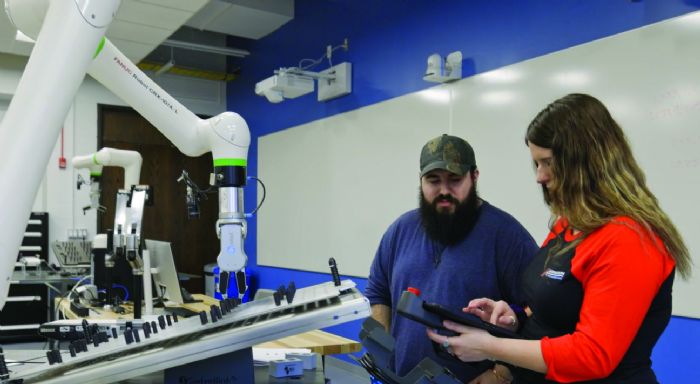 In speaking with Fanuc’s Aiello, he mentioned the well-developed robotics-related education program at Lorain County Community College (LCCC), in Elyria, OH, which also provides Industry 4.0 training in automation and robotics for high school teachers, as well as for educators at other colleges and universities. According to LCCC instructor Scott Zitek, who has been teaching automation-related subject matter for more than 30 yr., “with this course we provide students with basic foundation skills toward earning a degree in Automation Technology. Students also are prepared to earn a Fanuc Robotics CERT Handling Tool Operations and Programming level 1 certification.” In speaking with Fanuc’s Aiello, he mentioned the well-developed robotics-related education program at Lorain County Community College (LCCC), in Elyria, OH, which also provides Industry 4.0 training in automation and robotics for high school teachers, as well as for educators at other colleges and universities. According to LCCC instructor Scott Zitek, who has been teaching automation-related subject matter for more than 30 yr., “with this course we provide students with basic foundation skills toward earning a degree in Automation Technology. Students also are prepared to earn a Fanuc Robotics CERT Handling Tool Operations and Programming level 1 certification.”
Adds Kelly Zelesnik, dean of engineering business and information technologies: “We’ve worked to make the program reflect the needs of industry—more comprehensive in terms of interoperability and integration of automation, including content related to sensor technology, Internet of Things and cybersecurity. And, we’ve just in the last several months developed an applied bachelor’s degree in Smart Manufacturing, approved by the Ohio Department of Education.” Altogether, the LCCC robotics-related curriculum: - Certificate of Completion in robotics operator
- Industry 4.0 training in Automation and Robotics for teachers
- Associate of Applied Science in Automation Engineering Technology—Maintenance/Repair
- Applied bachelor’s degree in Smart Manufacturing.
“The end game,” says Zelesnik, “is to widen the pipeline to the talent that manufacturers require in order to have the confidence that, should they invest in automation technology, they’ll have a solid supply of well-trained engineers, technicians and operators at the ready.” “We’re taking this messaging to our local high schools,” explains Courtney Tenhover, a program developer at LCCC in engineering, business and information technologies. “Students can earn college credits, and we’re providing stackable certificates—with embedded industry certifications such as the Fanuc certification—that allow them to reach their desired level of education and become very employable.” Adds Zelesnik: “For us as a community college to be able to offer a bachelor’s degree, we required strong support from local manufacturers, and several wrote letters to the state explaining why our program was needed. Ultimately, the difference-maker was the hands-on and applied nature of our curriculum.” And, the relationship with the local manufacturing base never ends. Zitek explains: “As our students spend time working with manufacturers, while still taking classes in the evenings, we’re always asking them for feedback on how they’re doing and if we’re teaching the right skills. They love to tell us how they’re applying what they’ve learned here, which not only helps us but also makes them much more engaged with their employers.” |
Another robot vendor heavily invested in workforce development: Fanuc America.“Several years ago, we focused our training on teaching the discrete skill of operating a robot or a CNC machine,” says Fanuc’s Paul Aiello, executive director of the firm’s certified education group. “Today, with the integration of vision systems and other devices into robotic production cells, there is a tremendous need for people to understand Ethernet, networking protocols, PLCs and ladder logic, and HMIs and how they communicate with a robot in a system. So, an operator not only needs to know how a robot works but how it works within a connected system.”
Fanuc, as it seeks to support development of the automation-focused workforce of the future, preaches this overarching philosophy:
“Access to a highly skilled workforce is the most critical element for innovation and success in today’s manufacturing. Industry-recognized certifications and apprenticeships are essential in developing a workforce that will maximize investment in automation technology and drive global competitiveness.”
Three Critical Areas of Expertise
“We’ve identified three critical areas on which students need to focus to meet industry demands,” explains Aiello: “Automation, process-control technology and the digital thread. These are the types of opportunities that should be broadcast and communicated to students searching for stable, good-paying jobs where they can use their minds as well as their hands.”
Accomplishing such a lofty mission has, for the last several years, had Aiello and his team closely evaluating and improving their approach with educational institutions charged with training automation and robotics personnel.
“Some time ago we concluded that many schools were teaching outdated programs using outdated robots and other equipment,” he says. “So, we decided, starting in 2010, to establish partnerships with schools around the country and provide them with the newest robot and CNC technology. We also helped develop updated curriculum to train and certify instructors, and provided simulation tools—everything they need to establish current, relevant robotics programs.”
Since that time, Fanuc has established more than 1500 of these education-focused partnerships, turning out thousands of trained robot professionals annually.
“The schools purchase (for $35,000) a robot training cell,” Aiello says, “and we, in turn, provide a $320,000 gift-in-kind that includes all of the instructor training and certification they need, including the curriculum and simulation software. We’ve said to every school that if you have an industry advisory board of local employers, install the technology that those employers have.
“The product you’re providing is the automation program that will create a pipeline of skilled graduates, and the employers are your customers,” he adds.
Third-Party Certification
Aiello also points out that Fanuc, in addition to partnering with schools, also works with military transition-assistance programs, veterans’ programs and programs established in underserved communities. And, he adds that Fanuc does not self-credential students completing the training, opting to instead offer credentialing through a third party, NOCTI, formerly the National Occupational Competency Testing Institute, which certifies students in three areas: operator, focusing on the basics of robotic technology; technician, learning how Fanuc robots work together within a system; and integrated systems specialist (the newest certification), focused on advanced skills that, as Aiello says, are in high demand in manufacturing.
“These certifications are for those who understand how the various systems work together and know how to operate, maintain and troubleshoot a system,” explains NOCTI vice president Anne Gielczyk. “The operator and technician levels have a written component as well as a performance, hands-on component to test students on essential occupational skills for robotic operation. In addition, the performance component includes more applications within Industry 4.0.”
NOCTI works in many industries providing pre-employment testing, technical-skills assessments and certifications for companies to determine if they are hiring technically competent employees. Manufacturers can use the Fanuc certifications to ensure they are hiring Fanuc-trained robot experts who have passed industry-validated tests with a legally defensible passing score.
“Our tests are useful tools for improving worker safety and supplementing on-the-job training,” Gielczyk shares. “Our relationship with Fanuc started in 2016, as it sought a third-party nationally validated certification assessment to go along with its training program. We worked with subject-matter experts from industry and education to develop training and assessments to address what industry needs, not just what the instructors currently teach.
“I believe that much of the skills gap and breakdown,” continues Gielczyk, “results from a lack of communication between education and industry. It’s necessary to bridge that gap to ensure that education turns out technicians that industry needs.”
Yaskawa Motoman Working to Bridge This Gap
When it comes to bridging the gap between education and industry, Chapman at Yaskawa Motoman points again to the success Butler Tech has had in the state of Ohio.
“Butler, as have several other Ohio educational institutions, has done a great job partnering with local manufacturers,” Chapman says, “to provide real-world production challenges for students to tackle.”
Chapman notes that it’s important for manufacturers to differentiate between the various robot-related roles.
“The role of a robot operator differs greatly from that of a programmer,” he stresses, “which requires training in how to position the robot and perform time-motion studies to optimize efficiency. That’s a different skill set from that of a robot operator that pushes the on/off buttons and loads and unloads a welding fixture, and perhaps can troubleshoot the welding process itself.”
In a collaborative effort similar to Fanuc’s, Yaskawa Motoman has teamed with GennFlex, a company that’s developed a modular robot-training platform designed for educational institutions and manufacturing companies. GennFlex offers this platform for purchase or lease, along with a comprehensive curriculum.
Anton Koretskov, GennFlex vice president of business development, explains that it initially set out to create an open-source standardized hardware platform for automation and robotics training that seamlessly integrates with equipment from various original equipment manufacturers. As it developed the platform, it recognized the importance of also standardizing the introductory training curriculum. “Acquiring programming skills for one robot brand facilitates the learning process for other languages and working with robots from different manufacturers,” Koretskov says, noting that about 80 percent of the core programming skills acquired for one robot brand can be applied to robots from other manufacturers.
While the GennFlex platform addresses the need for core programming knowledge, it does not directly solve the shortage of skilled labor in welding, press brake operation and other applications. GennFlex, therefore, also seeks to bridge the gap between operator and programmer roles, which historically has required extensive training. To tackle this challenge, it has embraced emerging technologies in artificial intelligence (AI) and robotics and partnered with the German software company Wandelbots. As stated on the Wandelbots website: “No-code = no programming needed.”
GennFlex already has installed and commissioned the first robotic-welding cell powered by Wandelbots’ software at the Gakuto Robotics Club, a nonprofit organization dedicated to STEM and advanced manufacturing training, and a certified GennFlex training provider. The club’s 12,000-sq.-ft. automation and robotic training facility, in Wheeling, IL, is set to open to the public in July 2023. It will offer a comprehensive Welding Robot Operator/Programmer course that, according to Koretskov, can be completed in just two weeks, including a 32-hr. introductory course and 8 hr. of training on the Wandelbots software. Also included is 24 hr. of welding training (on Fronius equipment) and 16 hr. of practical programming and welding training on the welding cell.
The GennFlex Curriculum
…aims to keep things as simple as possible, explains Koretskov, adding that overly complicated training programs can hinder learning, creating barriers and discouraging students.
“One of the major challenges we face in the era of Industry 4.0,” he says, “is the need to train a large number of workers who can safely and efficiently operate and program automated equipment for various tasks.”
GennFlex offers access to all of its introductory courses, including robotics and machine vision, through its online learning-management system (LMS). To offset the costs of maintaining the LMS, it charges a nominal monthly fee of $5.
A key focus for GennFlex is training instructors for schools, universities and other workforce-training organizations. These certified instructors, once trained by GennFlex, then can educate the next generation of workers that our industries desperately need.
“Certified instructors have the privilege of training and certifying students without the burden of high maintenance or access fees,” Koretskov says. “We aim to empower instructors by providing them with the necessary tools and resources to deliver high-quality training without financial constraints.”
Advanced Training
In addition to its standard curriculum, GennFlex offers advanced courses designed to provide students a deeper dive into automation, covering topics such as advanced robot programming, vision systems and control-system design. “We developed the curriculum in accordance with NIMS (National Institute for Metalworking Skills) standards,” Koretskov says, “and expect NIMS certification to come soon.”
Lastly, Koretskov and his team are working with ASTM Committee F45 (Robotics, Automation and Autonomous Systems) to finalize development of a standard for robot education.
“Just this past April we submitted a proposal to create the New Specification for Robotic to Educational Standard, ASTM WK84838,” he says, “a standard to guide robotic educational training. Specifically, we envision a training platform based on standardized hardware—interconnectable, interchangeable and affordable—to facilitate learning. The goal is to make it easier for schools and manufacturing companies to train the automation experts that the manufacturers must have in order to remain viable, competitive and profitable.” MF
See also: Yaskawa America, Inc., FANUC America, Inc.
Technologies: Pressroom Automation
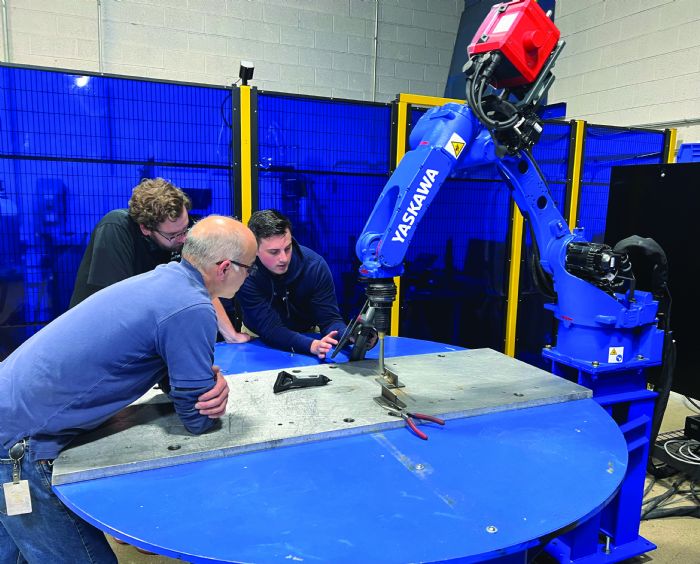 This directive became clear during our recent MetalForming Live on the Shop Floor online broadcast, when our featured speakers shared these words of wisdom:
This directive became clear during our recent MetalForming Live on the Shop Floor online broadcast, when our featured speakers shared these words of wisdom: 






 Robot vendors such as Yaskawa Motoman and Fanuc, faced with knowing that their customers struggle to hire and retain trained robot operators, programmers and maintenance technicians, continue to develop new tools to overcome workforce-related challenges. Explains Fanuc’s Paul Aiello:
Robot vendors such as Yaskawa Motoman and Fanuc, faced with knowing that their customers struggle to hire and retain trained robot operators, programmers and maintenance technicians, continue to develop new tools to overcome workforce-related challenges. Explains Fanuc’s Paul Aiello: In speaking with Fanuc’s Aiello, he mentioned the well-developed robotics-related education program at Lorain County Community College (LCCC), in Elyria, OH, which also provides Industry 4.0 training in automation and robotics for high school teachers, as well as for educators at other colleges and universities. According to LCCC instructor Scott Zitek, who has been teaching automation-related subject matter for more than 30 yr., “with this course we provide students with basic foundation skills toward earning a degree in Automation Technology. Students also are prepared to earn a Fanuc Robotics CERT Handling Tool Operations and Programming level 1 certification.”
In speaking with Fanuc’s Aiello, he mentioned the well-developed robotics-related education program at Lorain County Community College (LCCC), in Elyria, OH, which also provides Industry 4.0 training in automation and robotics for high school teachers, as well as for educators at other colleges and universities. According to LCCC instructor Scott Zitek, who has been teaching automation-related subject matter for more than 30 yr., “with this course we provide students with basic foundation skills toward earning a degree in Automation Technology. Students also are prepared to earn a Fanuc Robotics CERT Handling Tool Operations and Programming level 1 certification.”